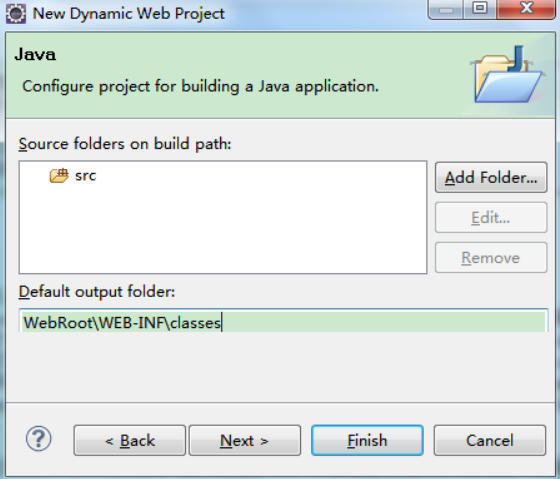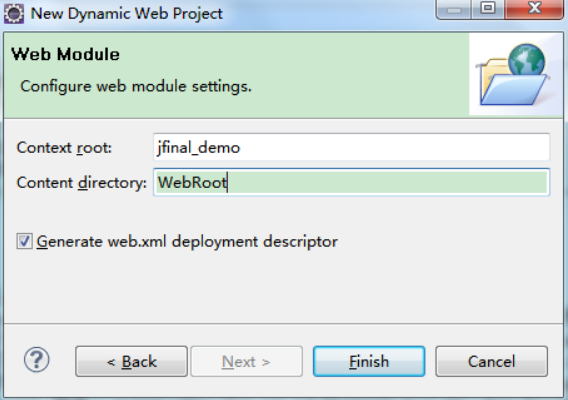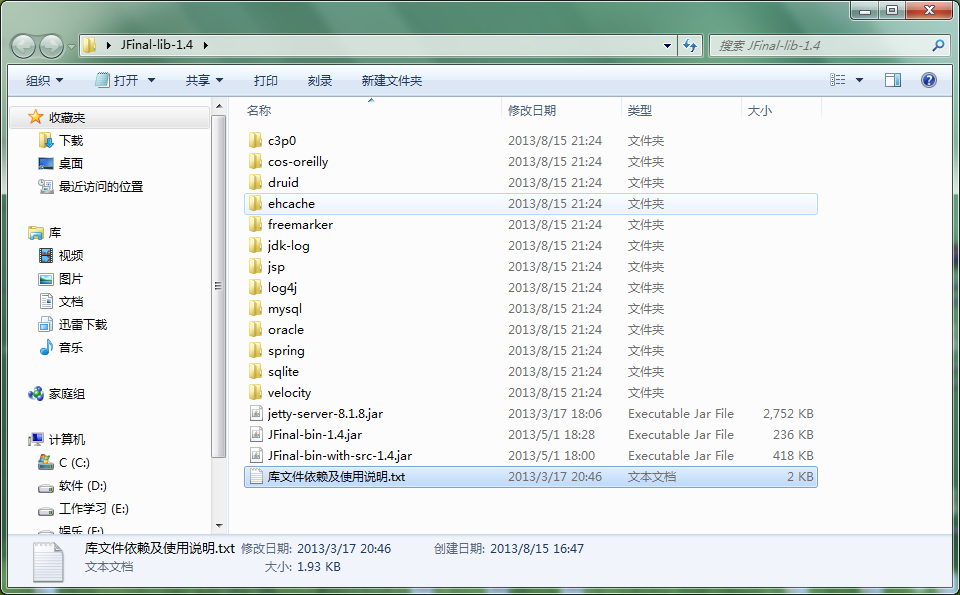jfinal 是 orm+mvc 而且有易與擴展的render plugin等機制。
JFinal框架也整合了Spring框架,下面實現JFinal怎麼去配置Spring框架。在JFinal中整合Spring使用到的類是SpringPlugin和IocInterceptor類。
Eclipse IDE for Java EE Developers 中
1、創建 Dynamic Web Project
2、修改 Default Output Folder,推薦輸入 WebRootWEB-INFclasses

特別注意:此處的 Default out folder 必須要與 WebRootWEB-INFclasses 目錄
完全一致才可以使用 JFinal 集成的 Jetty 來啟動項目。
3、修改 Content directory,推薦輸入 WebRoot

注 意 : 此 處 也 可 以 使 用 默 認 值 WebContent , 但 上 一 步 中 的
WebRootWEB-INFclasses 則需要改成 WebContentWEB-INFclasses 才能對應上。
4、去官網下載最新的jar包(我這是JFinal-lib-1.9)

把jetty-server-8.1.8.jar 和JFinal-bin-1.4.jar放到項目 WEB-INFlib下,jetty-server-8.1.8.jar是開發時使用的運行環境,用tomact和生產環境下就不需要了
5、添加到web.xml

<filter><filter-name>jfinal</filter-name><filter-class>com.jfinal.core.JFinalFilter</filter-class> <init-param><param-name>configClass</param-name><param-value>demo.DemoConfig</param-value> </init-param></filter><filter-mapping><filter-name>jfinal</filter-name><url-pattern>/*</url-pattern> </filter-mapping>
6、在項目 src 目錄下創建 demo 包,並在 demo 包下創建 DemoConfig 文件, 內容如下:
package demo;import com.jfinal.config.*;public class DemoConfig extends JFinalConfig {public void configConstant(Constants me) {
me.setDevMode(true);
}public void configRoute(Routes me) {
me.add("/hello", HelloController.class);
}public void configPlugin(Plugins me) {}public void configInterceptor(Interceptors me) {}public void configHandler(Handlers me) {}
}
注意:DemoConfig.java 文件所在的包以及自身文件名必須與 web.xml 中的param-value 標簽內的配置相一致(在本例中該配置為 demo.DemoConfig)。
在 demo 包下創建 HelloController 類文件, 內容如下:
package demo;import com.jfinal.core.Controller;public class HelloController extends Controller {public void index() {
renderText("Hello JFinal World.");
}
}
6、右擊項目名

選中com.jfinal.core.JFinal ok
7、浏覽器輸入http://localhost/hello輸出內容為 Hello JFinal World 證明項目框架搭建完成。
注意:在 tomcat 下開發或運行項目時,需要先刪除 jetty-server-xxx.jar 這個包,否則會引起沖突。
(抄襲官網api,罪過罪過....)
jfinal真的挺簡單,迅速,強大的一個框架,沒有ssh的N多xml配置文件,後面做個簡單的學生信息管理,配合FreeMarker
jfinal集成spring
SpringIplugin類:
SpringPlugin 是作為 JFinal 的 Plugin 而存在的,所以使用時需要在 JFinalConfig 中配置SpringPlugin,以下是 Plugin 配置示例代碼:
@Override public void configPlugin(Plugins me) {
<span style="white-space:pre"> </span>//配置Spring掛件 me.add(new SpringPlugin()); }
若創建 SpringPlugin 對 象 時 未 指 定 構 造 方 法 中 的 形 參 , SpringPlugin 將 自動去WebRoot/WEB-INF 目錄下尋找 applicationContext.xml 作為配置文件進行初始化。您還可以通過另外兩個構造方法指定配置文件或 ApplicationContext 對象。
以前學習Spring養成了習慣將Spring的配置放在src下,這裡我還是放在src的spring包中,如下:
@Override public void configPlugin(Plugins me) { //配置Spring掛件, 自動找spring包中所有的xml配置文件 me.add(new SpringPlugin("classpath*:spring/*.xml")); }
IocInterceptor類:
IocInterceptor 攔截 action 並對其進行依賴注入,以下是示例代碼:
package com.tenghu.core.controller;import java.util.List;import com.jfinal.aop.Before; import com.jfinal.core.Controller;import com.jfinal.plugin.spring.Inject;import com.jfinal.plugin.spring.IocInterceptor;import com.tenghu.core.model.Users; import com.tenghu.core.service.LoginService;import com.tenghu.core.validator.LoginValidator;
@Before(IocInterceptor.class)public class IndexController extends Controller{ @Inject.BY_NAME private LoginService loginService; public void index(
){ List<Users> testList=Users.dao.find("select * from users"); setAttr("testList", testList); render("login.html"); }
public void login(){ String username=getPara("name"); String password=getPara("password");
if(loginService.login(username, password)){ renderText("登錄成功"); }else{ renderText("登錄失敗"); } }
}
上例將對 loginService 按屬性名稱進行注入。注解@Inject.BY_NAME 按屬性名進行注入,@Inject.BY_TYPE 按類型進行注入。不指定注入類型時將不會進行注入。
登錄服務接口與實現類:
package com.tenghu.core.service;public interface LoginService { /** * 登錄處理 */ public boolean login(String username,String password);
}
package com.tenghu.core.service.impl;import com.tenghu.core.service.LoginService;public class LoginServiceImpl implements LoginService
{ /** * 登錄處理 */ public boolean login(String username, String password) { if("admin".equals(username)&&"admin".equals(password))
{ return true; } return false; }
}
Spring配置文件:
<?xml version="1.0" encoding="UTF-8"?> <beans xmlns="http://www.springframework.org/schema/beans" xmlns:xsi="http://www.w3.org/2001/XMLSchema-instance" xmlns:aop="http://www.springframework.org/schema/aop" xmlns:tx="http://www.springframework.org/schema/tx" xsi:schemaLocation=" http://www.springframework.org/schema/beans http://www.springframework.org/schema/beans/spring-beans-2.5.xsd http://www.springframework.org/schema/aop http://www.springframework.org/schema/aop/spring-aop-2.5.xsd http://www.springframework.org/schema/tx http://www.springframework.org/schema/tx/spring-tx-2.5.xsd"
<span style="white-space:pre"> default-autowire="byName"</span>> <bean id="loginService" class="com.tenghu.core.service.impl.LoginServiceImpl"/></beans>
配置完成
JFinal Dao 集成到 Spring
最近公司其它部門的同事還有朋友都表示對jfinal有很大的興趣,我發現最主要的一點是jfianl極簡風格和牛x的開發效率讓大家為之興奮,尤其是jfinal的dao設計。至於沒有在新項目中進行嘗試,因為好多項目需要對事務尤其是多庫事務上進行處理,而這點也讓大家犯難了起來。公司目前的項目是基於springmvc+mybatis,所以我將jfinal dao 集成到spring上,利用spring 強大的事務抽象能力解決事務難題。
不說了,先上代碼。。
?
1?
1JFinalDaoConfig的作用就是將config與數據庫綁定,模型與config進行綁定,這個類的作用我相信大家如果對jfinal比較熟悉,應該不難理解。
jfianl Model、DbPro 的獲取和釋放連接采用了spring的DataSourceUtils進行替換
//conn = config.getConnection();
conn = DataSourceUtils.getConnection(config.getDataSource());
JdbcUtils.closeStatement(pst);
DataSourceUtils.releaseConnection(conn, config.getDataSource());
由於jfianl某些類的可見性,JFinalDaoConfig需要放到com.jfinal.plugin.activerecord下
這樣就可以利用spring的事務和jfinal dao的方便性了。